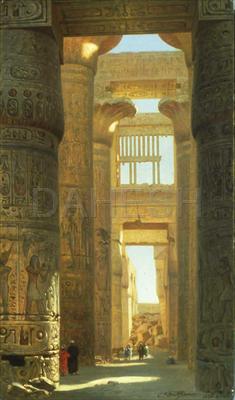Ernst Karl Eugen Koerner (German, 1846–1927)
The Temple of Karnak. The Great Hypostyle Hall, 1890
Oil on canvas, 31 1/4 x 18 1/4 in.
Signed and dated lower right: Ernst Koerner 1890
1995.114

During his travels in the Middle East, in 1873–74, Koerner certainly saw the vast dramatic temple district at Karnak dedicated to the god Amon-Ra, where perhaps the most impressive structure is the Great Hypostyle Hall. Even more capacious than St. Peter’s Basilica in Rome, this Hall contains 134 columns completely covered with detailed hieroglyphic reliefs depicting the Pharaoh Seti I and his son Rameses II. Most of the columns have papyrus bud capitals, like the two in the foreground; 12 taller columns measuring 12 feet in diameter, with papyrus blossom capitals, flank the main aisle. These organic forms, which once supported an 82-foot ceiling, symbolized the life force surrounding Amon-Ra, whom the ancient Egyptians believed created the universe. Koerner’s emphatic linear perspective and picturesque figures convey something of the Hall’s enormous scale, which was meant to emphasize the power of the gods and the insignificance of humans.


